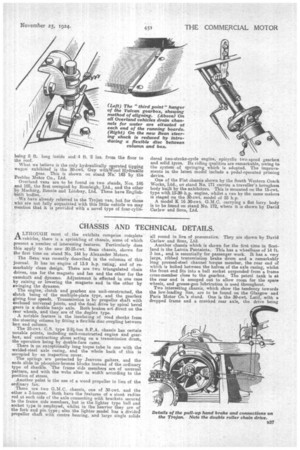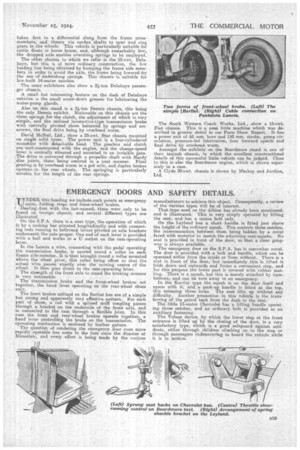CHASSIS AND TECHNICAL DETAILS.
Page 21

Page 23

If you've noticed an error in this article please click here to report it so we can fix it.
..t1A LTHOUGH most of the exhibits comprise complete
vehicles, there is a sprinkling of chassis, some of which present a number of interesting features. Particularly does this apply to the new 20-25-cwt. Bean chassis, shown for the first time on stand No. 144 by Alexander Motors.
The Bean was recently described in the columns of this journal. It has an engine of 13.9 h.p. rating, and of remarkably clean design. There are two triangulated chain drives, one for the magneto and fan and the other for the camshaft and dynamo. Adjustment is effected in one case by raising or lowering the magneto and in the other by swinging the dynamo.
The engine, clutch and gearbox are unit-constructed, the clutch being of the multiple-plate type, and the gearbox giving four speeds. Transmission is by propeller shaft with enclosed universal joints, and the final drive by spiral bevel gears in a double banjo axle. Both brakes act direct on the rear wheels, and they are of the duplex type.
A notable feature is the insulating of road shocks from the steering column by fitting a flexible disc coupling between box and column.
The 25-cwt. C.S. type 2-2&-ton S.P.A. chassis has certain notable points, including unit-constructed engine and gearbox, and contracting shoes acting on a transmission drum, the operation being by double-face cams.
There is an exceptionally long toque tuba in one with the welded-steel axle casing, and the whole 'back of this is occupied by an inspection cover. The springs are protected by Jeavons gaiters, and the ends slide in phosphor-bronze blocks instead of the ordinary type of shackle. The frame side members are of unusual pattern, and with the webs alter in width according to the position of stress.
Another point is the use of a wood propeller in lieu of the ordinary fan.
There are two G.M.C. chassis, one of 30 cwt. and the other a 3-tonner. Both have the features of a stout radius rod at each side of the axle connecting with brackets secured to the frame side members, but in the lighter type ball and socket type is employed, whilst in the heavier they are of the fork and pin type; also the lighter model has a divided propeller shaft with centre bearing, and large single solids all round in lieu of pneumatics. They are shown by David Carlaw and Sons, Ltd. Another chassis which is shown for the first time in Scotland is the Lancia Pentaiota. This has a wheelbase of 14 ft. 3 ins., and is essentially for passenger work. It has a. very large, ribbed transmission brake drum and a remarkably long pressed-steel channel torque member, the rear end of -which is bolted between the halves of the axle casing, whilst the front end fits into a ball socket suspended from a frame cross-member close to the gearbox. The petrol tank is at the rear and is scooped out to allow room for the spare wheels, and grease-gun lubrication is used throughout.
Two interesting chassis, which show the tendency towards the low-loading line, are to be found on the Glasgow and Paris Motor Co.'s stand. One is the 30-cwt. Latil, with a dropped frame and a cranked rear axle, the drive being taken first to a differential slung from the frame crossmembers, and thence via cardan shafts to spur and ring gears in the wheels, This vehicle is particularly suitable for cattle floats or horse boxes, and, although remarkably low, the dropped axle enables overslung springs to be employed.
The other chassis, to which we refer is the 25-cwt. Delahaye, but this is of more ordinary construction, the low loading line being obtained by humping the frame side members in order to avoid the axle, the frame being lowered .by the use of tinderslung springs. This chassis is suitable for low-built 14-seater coaches.
The same exhibitors also show a 24-ton Delahaye passenger chassis.
A small but interesting feature on the dash of Delabaye vehicles :s the small screw-down greaser for lubricating the water-pump glands..
Also on this stand is a 24-ton Dennis chassis, this being the only Dennis exhibit. Noticeable on this chassis are the three springs for the clutch, the adjustment of which is very simple, and the unlined locomotive-type transmission brake . with centrally pivoted shoes balanced by springs and setscrews, the final drive being by overhead worm.
David McNeil, Ltd., show a 25-cwt. Star chassis mounted on single solid tyres. The power unit is a four-eylindered monobloc with detachable head. The gearbox and clutch are unit-constructed with the engine and the change-speed lever is centrally situated and mounted in an invisible gate. The drive is.eonveyed through a propeller shaft with Hardy :disc joints, these being centred in a neat manner. Final gearing is by overhead worm in a pot axle, and duplex brakes .operate in .the rear, wheels. The springing is particularly notable for the length of the rear springs.
The South Western Coach Works, Ltd., show a 15-cwt. Fiat chassis. This is a neat little machine which was described in greater detail in our Paris Show Report, It has a. power unit of 65 mm. bore and 110 mm. stroke, pump circulation, pressure-fed lubrication, four forward speeds and final drive by overhead worm. Amongst the exhibits on the Beardmore stand is one of their taxicab chassis, in which the excellent constructional details of this successful little vehicle can be judged. Close to this is also the Beardmore engine, which is shown separately in a case. A Ltd Clyde 30-cwt. chassis is shown by Mackay and Jardine, .


































